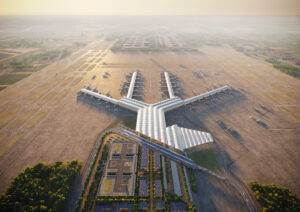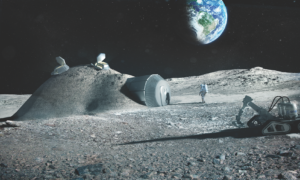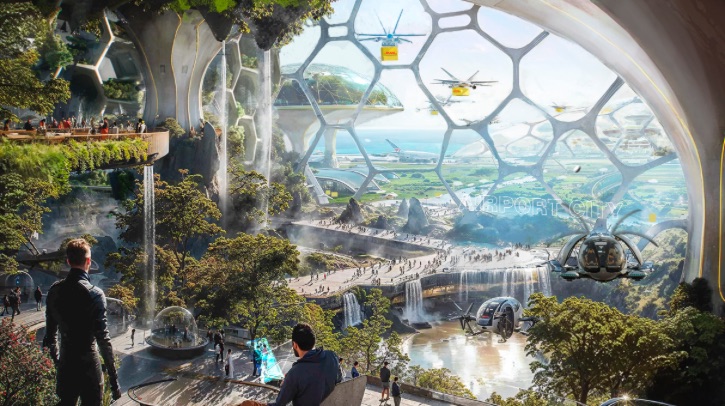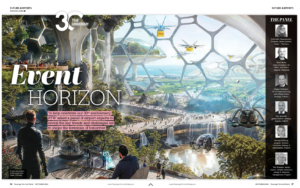Antoinette Nassopoulos-Erickson, senior partner at Foster + Partners, reveals the key trends and challenges set to shape the terminals of tomorrow.
What are the greatest challenges facing today’s airports?
Undoubtedly, the greatest challenge we face today is climate change. Aviation and airports represent 2-3% of GHG, which is rising as other sectors decarbonize more quickly. As we accelerate toward a global ambition of reaching net zero carbon, it is imperative that airports play their part and become more sustainable. As designers, we have a responsibility to convince our clients of the value associated with developing and operating airports in ways that are cognizant of a changing climate to lessen their impact on the environment and local communities. Airports should be designed to balance the economic benefits of growth, the needs of airlines and passengers, the cost of construction and the environmental impact of air travel.
Another key challenge is creating airport terminals that adequately reflect their context, while simultaneously taking advantage of the best new technologies to improve the passenger experience and manage facilities (from maintenance to energy systems optimization), and incorporating new AI tools. However, it is worth noting that the enormous potential of technology will not be realized without collaboration between regulators and the industry on data sharing.
How do these challenges shape and inform your approach?
Sustainability has always been central to the practice’s ethos. From inception to completion, we adopt a sustainable approach that drives our designs, from reviewing the optimal planning solutions at the start of a project to employing strategies for adaptation, incorporating passive design principles, optimizing the embodied carbon of materials, considering adaptability for disassembly and reuse, and taking advantage of the latest technologies to support optimization processes.
Foster + Partners is currently designing the new CPK Airport between Warsaw and Łód, a 21st-century transportation interchange that brings together air, rail and road while reflecting the country’s national identity and providing an exceptional passenger experience. Our client’s objective is to be ‘net zero ready’ from day one, which is defined as having technical readiness to be powered exclusively from on-site and off-site renewable energy sources for heating, cooling and power supply. This will support the continued drive to reduce energy demand and consumption by maximizing energy efficiency, using low- and zero-carbon technologies, incorporating passive design strategies and optimizing façade design.

The practice’s dedicated Environmental Design and Sustainability Group recently co-authored the World Green Building Council’s publication The Circular Built Environment Playbook. This publication includes a number of innovative ideas that we are using to design airports, including the ‘material passport’, a digital document listing all the materials that are included in a building during its lifecycle in order to facilitate strategizing circularity decisions. As chair of the IATA Airport Development Reference Manual (ADRM) sustainability group, I have also led the development of guidelines to provide a framework to effectively address the issue of climate change.
How might these challenges change in the future – and how might airports have to respond?
The rapid development of technology could enable a very different type of airport and passenger processing experience in the future. I can envision a fully automated, contactless passenger journey, using an internationally recognized digital identity, with an integrated flow management system that balances demand and capacity across all modes of transportation and provides seamless access to the airport gate from city centers. Terminals would have no queues and passengers would receive real-time, interactive travel communications.
Airports of the future, such as CPK Airport, will be vibrant hubs where terrestrial and airborne technologies converge, integrating driverless vehicles and autonomous flying taxis alongside high-speed train terminals. These vehicles could use digital biometric identity technologies to screen and verify travel documents and deliver passengers directly to their gates.

Some airports have already been disaggregated into a series of smaller terminals to enable more efficient passenger flows, rather than pushing all passengers through a central processing area. Our King Salman International Airport project breaks down the boundaries of the airport city and airside areas through the deployment of technology.
At Foster + Partners, we have long been exploring the possibilities of 3D printing to construct lunar and Mars habitats, while addressing the challenges of transporting materials into space. Our Spaceport America project articulates the thrill of space travel for space tourists while making a minimal impact on the environment. The project’s response to its place, respect for the local environment and integration of new aircraft and spacecraft are qualities that we will see in future airport design.
What new trends or technologies are already influencing how you approach airport design and air travel?

The transition to much quieter hydrogen and short-haul electric aircraft will positively affect adjacent airport communities. Furthermore, the integration of vertiports for EVtols is now a consideration in our planning – and is predicted to become more popular as more cities and airports start exploring strategies for incorporation.
We recently developed a concept design for a Skyports Infrastructure vertiport terminal next to Dubai International Airport (DXB) and worked on a cargo hyperloop. The DXB vertiport is one of four initial locations that are currently being considered by Skyports Infrastructure and Dubai’s Roads and Transport Authority (RTA). The sites form part of a vision for a future electric vertical take-off and landing (eVTOL) infrastructure network that will connect Dubai’s most popular – and populous – areas and provide high-speed, zero-emissions travel. The vertiport network will integrate with existing transportation hubs, including the RTA’s Dubai Metro network and Dubai International Airport.
There is also increasing confidence in autonomous systems for baggage and logistics, as well as the use of robotics for cleaning and food delivery. The increased takeup of biometrics for new passenger and baggage screening systems will speed up the passenger experience and let people travel directly to their aircraft.
What has had the greatest impact on airport design and operation over the last 30 years?
Technology, transportation, non-aeronautical revenues, increased security, automation, the pandemic, growth in leisure travel, passenger expectations and the climate crisis, to name just a few.
What has had the greatest impact on the actual design process itself – and what new design tools or technologies could change how you work in the future?
Over the past five years, we have seen huge advances in artificial intelligence (AI) and machine learning (ML). In the context of architecture and design, ML has great potential to analyze our designs more quickly and at less cost. At Foster + Partners, we embrace ML to enhance our knowledge, free designers from routine tasks and push the boundaries of design. The key to the successful application of AI and ML is access to quality data – and we have valuable data stores that are more than 50 years in the making.
How far away are we from a fully automated, seamless airport? How will human resources be best employed in such an airport?

With air passenger numbers expected to double by 2041, technology will be crucial for effectively handling this level of growth and enhancing the experience of travel. AI and ML are at the forefront of airport automation, driving improvements across various aspects of airport operations. Some airports are already seeing the benefits of AI-powered biometric technology, facial recognition systems, intelligent bag scanning mechanisms and the optimization of commercial concession opportunities. Robotics for passenger processing, cleaning maintenance and food service delivery are already being employed.
What was the best advice you were ever given with regard to how best to design an airport or approach a major design project?
Norman Foster has often said that the only constant is change. In the context of designing airports, change is inevitable as they have to be reactive to new technologies, market forces and politics. Furthermore, the scale of these projects means that they take longer to design and deliver, thus change will occur throughout the design process and often into the construction phases.
Some changes are driven by unforeseen events such as the Covid-19 pandemic, while others are led by government policy. For example, after the pandemic, the French government formally introduced a ban on direct domestic flights that could be replaced by a train ride lasting no more than 2.5 hours. Therefore, it is vital that we develop the most flexible design solutions, within the capital cost constraints, which facilitate future adaptation.
To quote Norman Foster again: “Everything we design is a response to the specific climate and culture of a particular place”. There is no ‘one size fits all’ design when it comes to airports. Every project is tailored to its unique context, from Beijing to Kuwait, Hong Kong to Panama, and Queen Alia in Jordan to Aeroport Marseille Provence.
What are some of your favorite quotes or thoughts about the future – and if you could make one wish, what would it be?
‘To embrace the future in the masterplan of a city or in the design of a building is an act of forward-thinking optimism’ – Norman Foster.
I really like this quote as it reminds me of the profoundly positive power of good design. My wish is to make a positive contribution to this world, making it better for everyone, everywhere.
This article originally appeared in the September 2024 issue of Passenger Terminal World. To view the magazine in full, click here.



